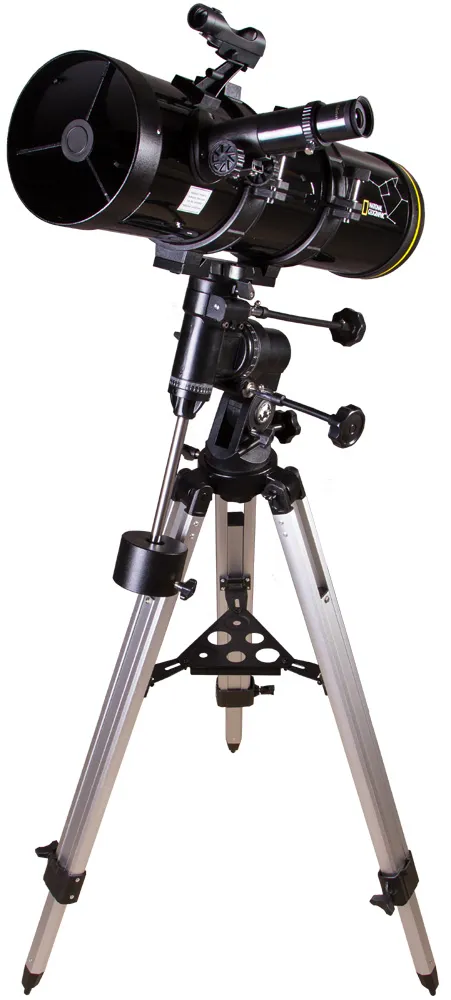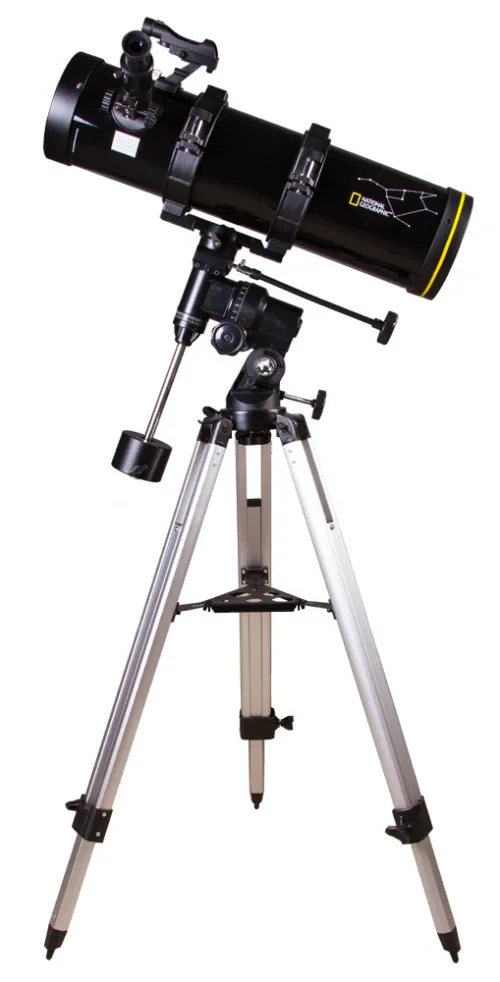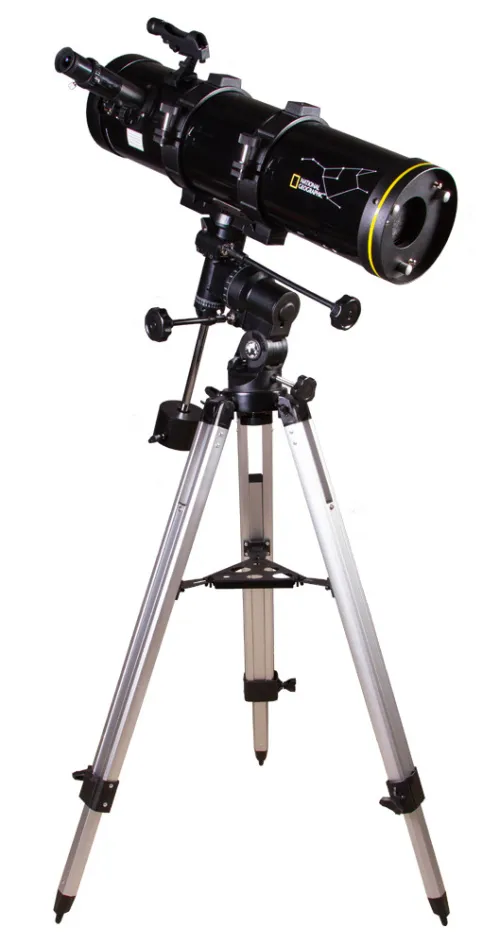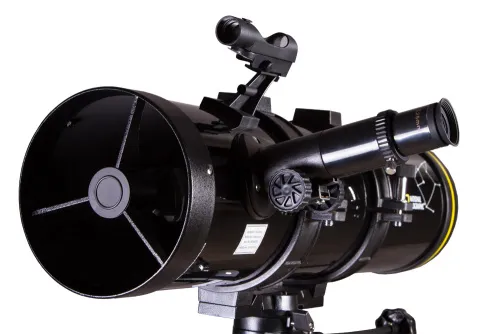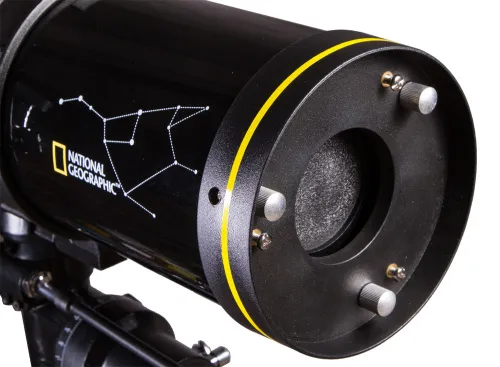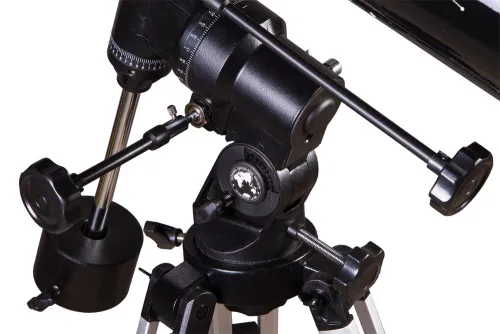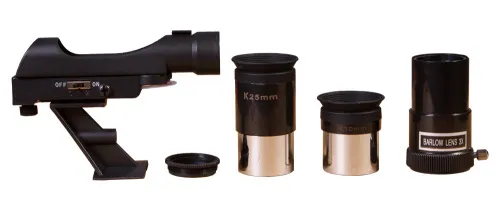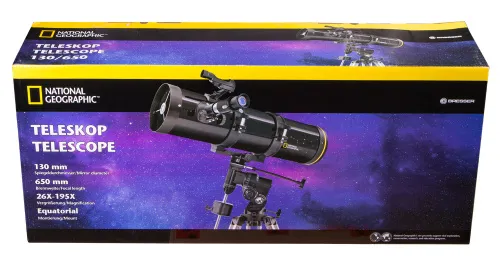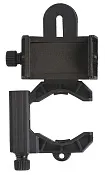Bresser National Geographic 130/650 EQ Telescope
Newtonian telescope. Primary mirror diameter (aperture): 130mm. Focal length: 650mm
| Product ID | 69377 |
| Brand | Bresser GmbH, Germany |
| Warranty | 2 years |
| EAN | 4007922001005 |
| Package size (LxWxH) | 40x89x25 cm |
| Shipping Weight | 12.82 kg |
Bresser National Geographic 130/650 EQ Telescope is a Newtonian reflector with a large 130mm aperture that gathers enough light to show you objects inside and even outside the Solar System. The relatively short focal length (650mm) makes the telescope very compact, and therefore convenient for field observations. A stable and reliable EQ3 equatorial mount harmoniously supplements this telescope. It is ideally adapted for long-term observation of moving objects, as it perfectly compensates the diurnal motion of the celestial sphere.
The basic kit includes two Kellner eyepieces (10mm and 25mm) with 1.25" barrel diameter and a 3x Barlow lens. To increase contrast during observations of the Moon, use the supplied lunar filter. The telescope also comes with a convenient rotating star chart that will help you navigate the night sky.
Features:
- Newtonian reflector with large aperture
- Compact model with relatively short focal length
- Stable and reliable EQ3 equatorial mount
- All necessary accessories are included
The kit includes:
- Bresser National Geographic 130/650 EQ Telescope
- EQ3 equatorial mount
- Aluminum tripod
- Accessory tray
- Eyepiece K25mm, 1.25"
- Eyepiece K10mm, 1.25"
- 3x Barlow lens
- Red Dot finderscope
- Focus wheel
- counterweight
- Mounting tube rings
- Rotating star chart
- Moon filter
- Rotatable star chart
- Planetarium software
- User manual
| Product ID | 69377 |
| Brand | Bresser GmbH, Germany |
| Warranty | 2 years |
| EAN | 4007922001005 |
| Package size (LxWxH) | 40x89x25 cm |
| Shipping Weight | 12.82 kg |
| Optical design | reflector |
| Optical scheme | Newtonian |
| Objective lens diameter (aperture), mm | 130 |
| Focal length, mm | 650 |
| Magnification, x | 26 — 195 |
| Aperture ratio | f/5 |
| Eyepieces | K10mm, Kellner K25mm |
| Eyepiece barrel diameter, in | 1.25 |
| Barlow lens | 3x |
| Finderscope | red dot |
| Filters included | lunar |
| Tripod | aluminum |
| Accessory tray | ✓ |
| Telescope control | manual |
| Mount | equatorial, EQ3 |
| Counterweights | yes |
| User level | beginners, experienced users |
| Observed object | deep-sky objects |
Convenient diagrams that describe how to install additional accessories on refractors and catadioptric telescopes
Find out how to assemble a telescope on an example of the Levenhuk Skyline 90x900 EQ telescope
This short guide will help you avoid typical mistakes and learn more about telescope and mounting types
The basics of astronomical observations for beginners
In this article we have gathered answers to some of the most frequently asked questions about telescopes
How telescopes work?
You can actually perform observations from your balcony!
All about telescope sizes, types, magnification, and mounts
Learn how to set up and use the telescope properly
Astronomy in light-polluted skies. Find out what you can observe in the city
Read an interesting comprehensive article on telescopes for little astronomers
Celestial objects you can observe with telescopes of different apertures
Colored and vivid images of galaxies, planets and star clusters entrance everyone who is fascinated by boundless space
Find an interesting review on the history of the changes to a refracting telescope
To make the process of choosing a telescope easier, we will tell you about the characteristics of the most popular types of telescopes today
Learn everything you need to know about refractor telescopes to make the right choice

